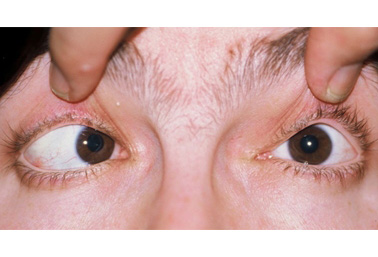History and exam
Key diagnostic factors
common
asymptomatic
There may be no complaint of any problems with vision. Amblyopia may only be suspected on routine childhood screening.
subnormal visual acuity for age in one or both eyes
Amblyopia is a reduction of best corrected visual acuity (usually unilateral, but may be bilateral) that is not attributable solely to a structural abnormality of the eye or visual pathways.[1]
Subjective visual acuity is the preferred testing method in children who can participate reliably with assessment, but instrument-based screening may be useful in children who cannot cooperate.[32]
uncommon
failure to ''fix and follow'' in infants
May be due to amblyopia.
Important feature of history particularly in infants ages 3-6 months.
abnormal red reflex
Abnormalities on exam with a direct ophthalmoscope include asymmetry in color or brightness, absence of reflex, or opacity noted within the reflex. May be an indication of media opacities, strabismus, or high refractive error.[1]
Other diagnostic factors
common
asymmetric corneal light reflex
A light is shone on the eyes from an arm's length away while the patient looks at a small toy held adjacent to the light. If the reflection of the light is symmetrically centered on the cornea in each eye, no manifest strabismus is present. If it is decentered in one eye, manifest strabismus is likely. [Figure caption and citation for the preceding image starts]: Esotropia: left eye fixating (note decentered light reflection on right cornea)From the collection of Daniel J. Salchow, MD [Citation ends].
unequal behavioral response to alternate eye occlusion
With normal vision the response should be equal on both sides (i.e., the infant should object or not object equally).
abnormal cover/uncover testing
Test performed if the child is cooperative to testing.
While the child is fixating (staring) at an object, the examiner should cover one eye and look for a refixation movement of the uncovered eye.
Then, the cover should be removed and placed over the other eye to again look for a refixation movement of the uncovered eye. A refixation movement in either eye indicates strabismus.
Children with strabismus require referral to an ophthalmologist for further assessment.
If the child constantly fixates with one eye and the other eye remains deviated, vision is decreased in the deviated eye, which is often due to strabismic amblyopia.
Strabismic children who alternate fixation between the two eyes and can maintain fixation through a blink with either eye probably do not have amblyopia.
uncommon
blurred vision
May indicate high refractive error or high astigmatism, which may result in amblyopia.
Older children may complain of blurred vision, but most older children with amblyopia, especially if unilateral, are unaware of their visual deficit.
eye strain
Older children with amblyopia may complain of eye strain, but this is uncommon.[3]
congenital nystagmus
abnormal pupil exam
May indicate ocular pathologies that may be contributing to decreased vision (e.g., abnormal pupillary response may be due to optic nerve hypoplasia or retinal pathology). May be the sole cause of decreased vision or may be associated with amblyopia, especially if unilateral.
Children or infants with abnormalities in pupillary shape, pupils of unequal size, or poor and unequal reaction to light should be referred to an ophthalmologist.
abnormal external eye exam
Children or infants who have structural abnormalities of the eye, eyelids, or orbit detected through external inspection should be referred to an ophthalmologist for further investigation. A penlight is sufficient for external inspection of the eye.
Severe ptosis is associated with developing form-deprivation amblyopia.
Risk factors
strong
age <9 years
strabismus
high (uncorrected) refractive errors
Significant refractive errors are risk factors for unilateral amblyopia.[13] Bilateral astigmatism and significant bilateral hyperopia are risk factors for bilateral amblyopia.
Visually significant refractive errors that increase the risk of amblyopia include: anisometropia >1.25 diopters (D), hyperopia >4.00 D, myopia <-3.00 D (in children <4 years), myopia <-2.00 D (in children ≥4 years), and astigmatism >3.00 D (in children <4 years).[21]
Amblyopia typically does not occur in patients with low to moderate refractive errors.
media opacity
Media opacities >0.1 mm in size are amblyogenic.[21]
Opacities in the cornea, anterior chamber, lens, vitreous chamber, or retinal surface increase the risk of amblyopia (e.g., congenital cataract, corneal opacity, nonclearing vitreous hemorrhage, and macular hemorrhage).
Unilateral occlusion tends to be worse than bilateral occlusion of similar magnitude, because interocular competition adds to the direct developmental impact of severe image degradation.[1]
severe ptosis or prolonged occlusion of one or both eyes
May result in form-deprivation amblyopia.[1]
weak
prematurity
Premature infants are at increased risk of refractive errors (primarily hyperopia and astigmatism) and of strabismus, which increase the risk of amblyopia.[22][23][24][25]
Bronchopulmonary dysplasia, cortical white matter damage, levothyroxine use, retinopathy of prematurity treatment, and invasive ventilation in preterm infants have been reported as risk factors for amblyopia.[25][26]
Conditions that cause form-deprivation amblyopia (e.g., congenital cataract) occur more frequently in infants born prematurely.[27]
family history of amblyopia or strabismus
Amblyopia is more likely in the presence of a family history of amblyopia or strabismus.[28]
Siblings of children with accommodative esotropia (inward turning of the eye on accommodation; a type of strabismus that commonly leads to amblyopia) have a high prevalence of amblyogenic risk factors, including strabismus, moderate to high hyperopia, moderate to high astigmatism, and anisometropia.[29]
Rates of accommodative esotropia are high among children with moderate to high hyperopia and parents with a history of strabismus.[30]
developmental delay
Amblyopia occurs more often among children with developmental delay, such as cerebral palsy, global development delay, developmental delay with seizures, and Down syndrome.[1][31]
Approximately 86% of these children are reported to have ocular findings, with refractive errors (68%) and strabismus (51%) being common.[1][31]
structural abnormality of the retina or vitreous
Can result in vision loss and amblyopia (analogous to form deprivation).[1]
Causes include optic nerve hypoplasia, myelinated nerve fiber layer, macular dragging from retinopathy of prematurity, and uveitis.
Use of this content is subject to our disclaimer